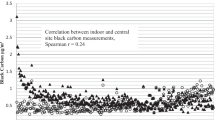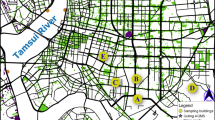Abstract
The Relationship of Indoor, Outdoor and Personal Air (RIOPA) study was designed to investigate residential indoor, outdoor and personal exposures to several classes of air pollutants, including volatile organic compounds, carbonyls and fine particles (PM2.5). Samples were collected from summer, 1999 to spring, 2001 in Houston (TX), Los Angeles (CA) and Elizabeth (NJ). Indoor, outdoor and personal PM2.5 samples were collected at 212 nonsmoking residences, 162 of which were sampled twice. Some homes were chosen due to close proximity to ambient sources of one or more target analytes, while others were farther from sources. Median indoor, outdoor and personal PM2.5 mass concentrations for these three sites were 14.4, 15.5 and 31.4 μg/m3, respectively. The contributions of ambient (outdoor) and nonambient sources to indoor and personal concentrations were quantified using a single compartment box model with measured air exchange rate and a random component superposition (RCS) statistical model. The median contribution of ambient sources to indoor PM2.5 concentrations using the mass balance approach was estimated to be 56% for all study homes (63%, 52% and 33% for California, New Jersey and Texas study homes, respectively). Reasonable variations in model assumptions alter median ambient contributions by less than 20%. The mean of the distribution of ambient contributions across study homes agreed well for the mass balance and RCS models, but the distribution was somewhat broader when calculated using the mass balance model with measured air exchange rates.
This is a preview of subscription content, access via your institution
Access options
Subscribe to this journal
Receive 6 print issues and online access
$259.00 per year
only $43.17 per issue
Buy this article
- Purchase on Springer Link
- Instant access to full article PDF
Prices may be subject to local taxes which are calculated during checkout





Similar content being viewed by others
References
Abt E., Suh H.H., Allen G., and Koutrakis P. Characterization of indoor particle sources: a study conducted in the Metropolitan Boston area. Environ Health Perspect 2000a: 108: 35–44.
Abt E., Suh H.H., Catalano P., and Koutrakis P. Relative contribution of outdoor and indoor particle sources to indoor concentrations. Environ Sci Technol 2000b: 34: 3579–3587.
Ansari A.S., and Pandis S.N. Response of inorganic PM to precursor concentrations. Environ Sci Technol 1998: 32: 2706–2714.
Chao C.Y.H., Tung T.C.W., and Burnett J. Influence of different indoor activities on the indoor particulate levels in residential buildings. Indoor Built Environ 1997: 7: 110–121.
Chuersuwan N., Turpin B.J., and Pietarinen C. Evaluation of time-resolved PM2.5 data in urban/suburban areas of New Jersey. J Air Waste Manag Assoc 2000: 50: 1780–1789.
Clayton C.A., Perritt R.L., Pellizzari E.D., Thomas K.W., and Whitmore R.W. Particle total exposure assessment methodology (PTEAM) study: distributions of aerosol and elemental concentrations in personal, indoor, and outdoor air samples in southern California community. J Expos Anal Environ Epidemiol 1993: 3: 227–250.
Dietz R.N., Goodrich R.W., Cote E.A., and Wieser R.F. Detailed description and performance of a passive perfluorocarbon transfer system for building ventilation and air exchange measurements. In: Trechel H.R., and Laqus (eds.). Measured Air Leakage of Buildings. ASTM STP 904, American Society of Testing and Materials, Philadelphia, PA, 1986: pp. 203–264.
Goldberg M.S., Burnett R.T., Bailar J.C., Brook J., Bonvalot Y., Tamblyn R., Singh R., and Valois M.F. The association between daily mortality and ambient air particle pollution in montreal, Quebec. Environ Res Sect A 2001: 86: 12–25.
Jones N.C., Thornton C.A., Mark D., and Harrison R.M. Indoor/outdoor relationships of particulate matter in domestic homes with roadside, urban and rural locations. Atmos Environ 2000: 34: 2603–2612.
Koistinen K.J., Hanniene O., Rotko T., Edwards R.D., Moschandreas D., and Jantunen M.J. Behavioral and environmental determinants of personal exposures to PM2.5 in EXPOLIS—Helsinki, Finland. Atmos Environ 2001: 35: 2473–2481.
Koutrakis P., Briggs S.L.K., and Leaderer B.P. Source apportionment of indoor aerosols in Suffolk and Onondaga counties New York. Environ Sci Technol 1992: 26: 521–527.
Lachenmyer C., and Hidy G.M. Urban measurements of outdoor–indoor PM2.5 concentrations and personal exposure in the deep south Part I. Pilot study of mass concentrations for nonsmoking subjects. Aerosol Sci Technol 2000: 32: 34–51.
Lefcoe N.M., and Inculet I.I. Particulates in domestic premises II. Ambient levels and indoor, outdoor relationships. Arch Environ Health 1975: 30: 565–570.
Long C.M., Suh H.H., Catalano P.J., and Koutrakis P. Using time- and size-resolved particulate data to quantify indoor penetration and deposition behavior. Environ Sci Technol 2001: 35: 2089–2099.
Morandi M.T., Stock T.H., and Contant C.F. A comparative study of respirable particulate microenvironmental concentrations and personal exposures. Environ Monit and Assess 1988: 10: 105–122.
Mosley R.B., Greenwell D.J., Sparks L.E., Guo Z., Tucher W.G., Fortmann R., and Whitfield C. Penetration of ambient fine particles into the indoor environment. Aerosol Sci Technol 2001: 34: 127–136.
Naumova Y.Y., Totten L.A., Eisenreich S.J., Turpin B.J., Colome S.D., Morandi M.T., Weisel C.P., Stock T.H., Winer A.M., Alimokhtari S., Kwon J., Maberti S., Shendell D., Jones J., and Wall S.J. Polycyclic aromatic hydrocarbons in the indoor and outdoor air of three cities in the US.: results from the RIOPA study. Environ Sci Technol 2002: 36: 2552–2559.
Naumova Y.Y., Offenberg J.H., Eisenreich S.J., Polidori A., Meng Q.Y., Turpin B.J., Colome S.D., Morandi M.T., Weisel C.P., Stock T.H., Winer A.M., Alimokhtari S., Kwon J., Maberti S., Shendell D., and Jones J. An assessment of gas-particle distribution of polycyclic aromatic hydrocarbons in coupled outdoor/indoor atmospheres. Atmos Environ 2003: 37: 703–719.
Norris G., YoungPong S.N., Koenig J.Q., Larson T.V., Sheppard L., and Stout J.W. An association between fine particles and asthma emergency department visits for children in seattle. Environ Health Perspectives 1999: 107: 489–493.
Oglesby L., Kunzli N., Roosli M., Braun-Fahrlander C., Mathys P., Stern W., Jantunen M., and Kousa A. Validity of ambient levels of fine particles as surrogate for personal exposure to outdoor Air pollution—results of the European EXPOLIS-EAS Study (Swiss Center Basel). J Air Waste Manag Assoc 2000: 50: 1251–1261.
Ott W., Wallace L., and Mage D. Predicting particulate (PM10) personal exposure distributions using a random component superposition statistical model. J Air Waste Manag Associ 2000: 50: 1390–1406.
Ozkaynak H., Xue J., Spenglr J., Wallace L., Pellizzari E., and Jenkins P. Personal exposure to airborne particles and metals: results from the particle TEAM Study in Riverside, California. J Expos Anal Environ Epidemiol 1996: 6: 57–78.
Pandian M.D., Behar J.V., Ott W.R., Wallace L.A., Wilson A.L., Colome S.D., and Koontz M. Correcting errors in the nationwide data base of residential air exchange rates. J Expo Anal Environ Epidemiol 1998: 8: 577–586.
Pellizzari E.D., Clayton C.A., Rodes C.E., Mason R.E., Piper L.L., Fort B., Pfeifer G., and Lynam D. Particulate matter and manganese exposures in Toronto, Canada. Atmos Environ 1999: 33: 721–734.
Riley W.J., Mckone T.E., Lai A.C.K., and Nazaroff W.W. Indoor particulate matter of outdoor origin: importance of size-dependent removal mechanisms. Environ Sci Technol 2002: 36: 200–207.
Robinson J., and Nelson W.C. National Human Activity Pattern Survey Data Base. USEPA, Research Triangle Park, NC, 1995.
Schwartz J., Norris G., Larson T., Sheppard L., Claiborne C., and Koenig J. Episodes of high coarse particle concentrations are not associated with increase mortality. Environ Health Perspectives 1999: 107: 339–342.
Seinfeld J.H., and Pandis S.N. Atmospheric Chemistry and Physics. John Wiley & Son, Inc., New York, 1998.
Sexton K., Spengler J.D., and Treitman R.D. Personal exposure to respirable particles: a case study in Waterbury, Vermont. Atmos Environ 1984: 18: 1385–1398.
Spengler J.D., Treitman R.D., Tostenson T.D., Mage D.T., and Soczek M.L. Personal exposures to respirable particulates and implications for air pollution epidemiology. Environ Sci Technol 1985: 19: 700–707.
Thatcher T.L., and Layton D.W. Deposition, resuspension, and penetration of particles within a residence. Atmos Environ 1995: 29: 1487–1497.
Thornburg J., Ensor D.S., Rodes C.E., Lawless P.A., Sparks L.E., and Mosley R.B. Penetration of particles into buildings and associated physical factors. Part I: Model development and computer simulations. Aerosol Sci Technol 2001: 34: 284–296.
Turpin B.J., Saxena P., and Andrews E. Measuring and simulating particulate organics in the atmosphere: Problems and prospects. Atmos Environ 2000: 34: 2983–3013.
USEPA. Air Quality Criteria for Particulate Matter. USEPA: Research Triangle Park, NC, 1996.
Vette A.F., Rea A.W., Lawless P.A., Rodes C.E., Evans G., Highsmith V.R., and Sheldon L. Characterization of indoor–outdoor aerosol concentration relationships during the fresno PM exposure studies. Aerosol Sci Technol 2001: 34: 118–126.
Wainman T., Zhang J.F., Weschler C.J., and Lioy P.J. Ozone and limonene in indoor air: a source of submicron particle exposure. Environ Health Perspect 2000: 108: 1139–1145.
Wallace L. Indoor particles: a review. J Air Waste Manag Assoc 1996: 46: 98–126.
Weisel C.P., Zhang J., Turpin B.J., Morandi M.T., Colome S., Stock T.H., Spektor D.M., Korn L., Winer A., Alimokhtari S., Kwon J., Mohan K., Harrington R., Maberti S., Shendell D., Giovanetti R., and Lee J.H. The Relationships of Indoor, Outdoor and Personal Air (RIOPA) Study: study design, methods and initial results. J Expos Anal Environ Epidemiol 2004, June 23 (epub ahead of print).
Weschler C.J., and Shields H.C. Potential reactions among indoor pollutants. Atmos Environ 1997: 31: 3487–3495.
Wilson A.L., Colome S.D., Tian Y., Becker E.W., Baker P.E., Behrens D.W., Billick I.H., and Garrison C.A. California residential air exchange rates and residence volumes. J Expos Anal Environ Epidemiol 1996: 6: 311–326.
Winkle M.R.V., and Scheff P.A. Volatile organic compounds, polycyclic aromatic hydrocarbons and elements in the air of ten urban homes. Indoor Air 2001: 11: 49–64.
Yakovleva E., Hopke P.K., and Wallace L. Receptor modeling assessment of particle total exposure assessment methodology data. Environ Sci Technol 1999: 33: 3645–3652.
Yocom J.E. Indoor–outdoor air quality relationships, a critical review. J Air Pollu Control Assoc 1982: 32: 500–520.
Acknowledgements
This research was supported by the Health Effects Institute, the Mickey Leland National Urban Air Toxics Center, the NIEHS Center of Excellence, the NJ Agricultural Experiment Station, and an EPA STAR Graduate Fellowship (for D. Shendell). We gratefully acknowledge the hard work of all the students and technicians in the field and laboratories of RIOPA investigators and the hospitality of the RIOPA participants. In addition, we thank Dr. Wayne Ott of Stanford University for his advice, and acknowledge the guidance of Dr. Glen Cass, who will be missed.
Research described in this article was conducted, in part, under contract to the Health Effects Institute (HEI), an organization jointly funded by the United States Environmental Protection Agency (EPA: Assistance Agreement R828112) and automotive manufacturers. The contents of this article do not necessarily reflect the views of HEI, nor do they necessarily reflect the views and policies of EPA or of motor vehicle and engine manufacturers.
Author information
Authors and Affiliations
Corresponding author
Rights and permissions
About this article
Cite this article
Meng, Q., Turpin, B., Korn, L. et al. Influence of ambient (outdoor) sources on residential indoor and personal PM2.5 concentrations: Analyses of RIOPA data. J Expo Sci Environ Epidemiol 15, 17–28 (2005). https://doi.org/10.1038/sj.jea.7500378
Received:
Accepted:
Published:
Issue Date:
DOI: https://doi.org/10.1038/sj.jea.7500378
Keywords
This article is cited by
-
Indoor Air Sensing: A Study in Cost, Energy, Reliability and Fidelity in Sensing
Sensing and Imaging (2023)
-
Infiltration of outdoor PM2.5 and influencing factors
Air Quality, Atmosphere & Health (2022)
-
A framework for estimating the US mortality burden of fine particulate matter exposure attributable to indoor and outdoor microenvironments
Journal of Exposure Science & Environmental Epidemiology (2020)
-
The impact of air exchange rate on ambient air pollution exposure and inequalities across all residential parcels in Massachusetts
Journal of Exposure Science & Environmental Epidemiology (2019)



